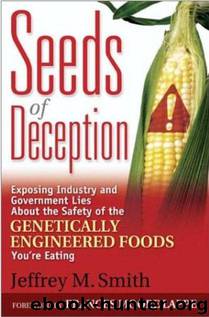Seeds of Deception by Smith Jeffrey

Author:Smith, Jeffrey [Smith, Jeffrey]
Language: eng
Format: mobi
Tags: GMO
Publisher: Yes! Books
Published: 2003-09-02T16:00:00+00:00
Chapter 6
Rolling The Dice With Allergies
When her one-year-old daughter developed an allergy to milk in February 1998, a leading British surgeon did what many other mothers do: she switched to soymilk. When the girl immediately developed large cold sores, the child was tested and found not to be allergic to soy. The mother figured it must be something else and continued feeding her soymilk. Over the next year the sores got worse and did not respond to treatment. “I became aware that she was not getting better,” said the mother. “There seemed to be three large, weeping sores on her face at any one time.”
From a geneticist friend, she learned about the potential risks of GM soy and tried reducing the daughter’s soymilk by one-fourth. “The sores cleared up overnight,” she recalled.
She told the Sunday Telegraph, “I want the government to look into this because I saw the change in my daughter—as soon as she was taken off the GM milk, her health dramatically improved. I and my [general practi-tioner] have not found any other reasons why she became ill. My family previously ate GM products without worrying—but now we do not.”[1]
Could the child have reacted to the GM soy but not natural soy?
It’s possible, but the limited details raise more questions than they answer. Did the allergy test use natural soy instead of GM soy, thereby missing her reaction to the GM variety? Was the reaction not an allergy but rather a food “intolerance” or “sensitivity” to GM soy? The mother’s geneticist friend even suggested that the cold sores were related to a virus that was being activated by the GM soy.
If GM soybeans were responsible for anything out of the ordinary such as increased allergies, then the total number of allergies attributed to soy would probably rise in the general population after GM soy was introduced into the diet. Unfortunately, very few countries maintain detailed statistics on food allergies. In the UK, however, the York Nutritional Laboratory, Europe’s leading specialist on food sensitivity, does extensive tests each year to determine how many people have allergies and to what foods.
In March 1999, York Laboratory scientists discovered that soy allergies skyrocketed over the previous year, jumping 50 percent. The increase propelled soy into the top ten list of allergens for the first time in the seventeen years of testing. Soy “moved up four places to ninth and now sits alongside foodstuffs with a long history of causing allergies, such as yeast, sunflower seeds and nuts,” reported the UK’s Daily Express.
Researchers tested 4,500 people for allergic reactions to a wide range of foods. In previous years, soy affected 10 percent of consumers. Now, 15 percent reacted with a range of chronic illnesses, including irritable bowel syndrome, digestion problems, and skin complaints including acne and eczema. (Note: Some of these reactions may fall into the category of food hypersensitivity or food intolerance, not food allergies per se. For the sake of this discussion, we will not distinguish between the categories.) According to
Download
This site does not store any files on its server. We only index and link to content provided by other sites. Please contact the content providers to delete copyright contents if any and email us, we'll remove relevant links or contents immediately.
| Fossils | Game Theory |
| Genetics | Molecular Biology |
| Organic | Paleontology |
Sapiens: A Brief History of Humankind by Yuval Noah Harari(14258)
Sapiens by Yuval Noah Harari(5297)
Pale Blue Dot by Carl Sagan(4917)
Homo Deus: A Brief History of Tomorrow by Yuval Noah Harari(4827)
Livewired by David Eagleman(3686)
Origin Story: A Big History of Everything by David Christian(3651)
Brief Answers to the Big Questions by Stephen Hawking(3369)
Inferior by Angela Saini(3278)
Origin Story by David Christian(3149)
Signature in the Cell: DNA and the Evidence for Intelligent Design by Stephen C. Meyer(3075)
The Gene: An Intimate History by Siddhartha Mukherjee(3050)
The Evolution of Beauty by Richard O. Prum(2939)
Aliens by Jim Al-Khalili(2788)
How The Mind Works by Steven Pinker(2734)
A Short History of Nearly Everything by Bryson Bill(2631)
Sex at Dawn: The Prehistoric Origins of Modern Sexuality by Ryan Christopher(2484)
From Bacteria to Bach and Back by Daniel C. Dennett(2448)
Endless Forms Most Beautiful by Sean B. Carroll(2432)
Who We Are and How We Got Here by David Reich(2399)
